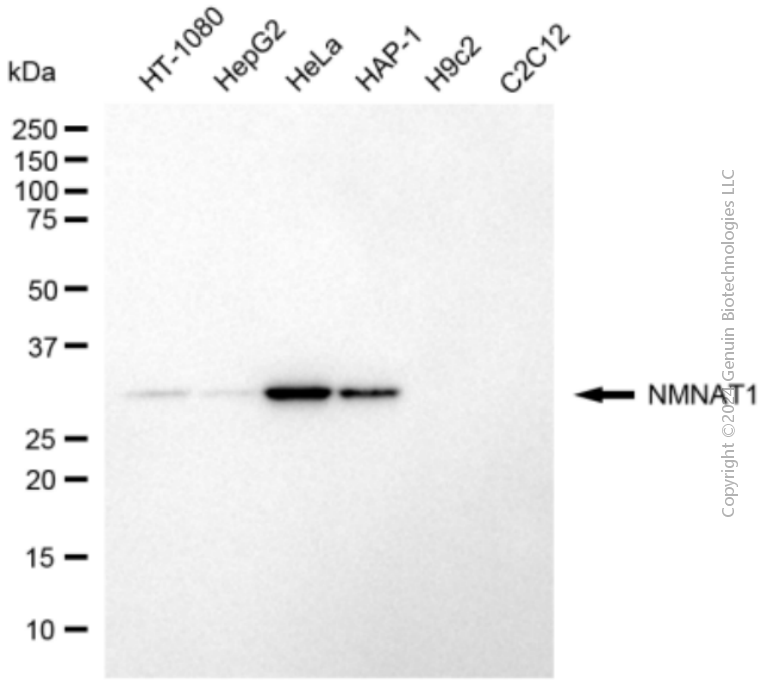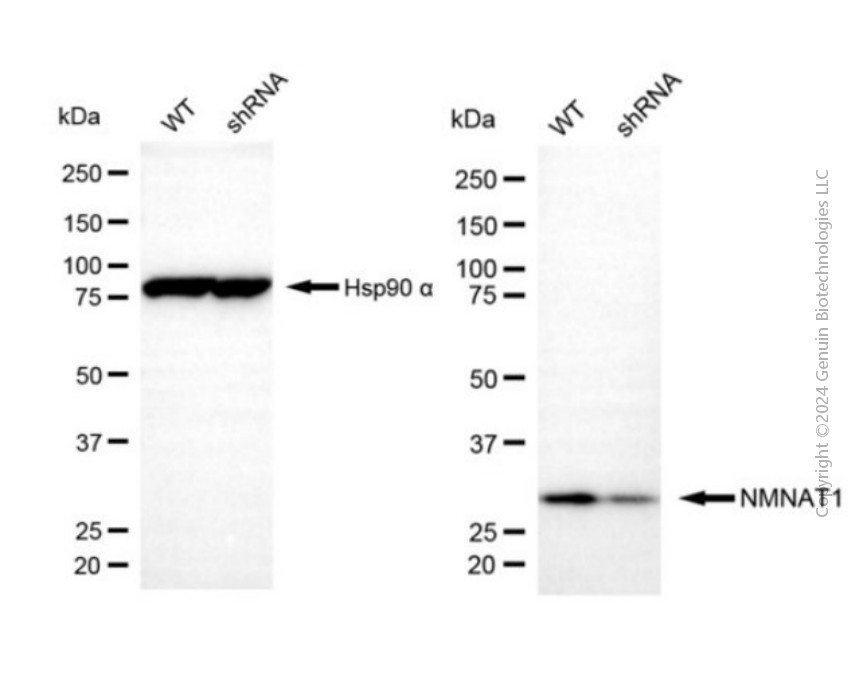KD-Validated Anti-NMNAT1 Mouse Monoclonal Antibody
Mouse monoclonal antibody
- SPECIFICATION
- CITATIONS
- PROTOCOLS
- BACKGROUND

Application
| WB |
|---|---|
| Primary Accession | Q9HAN9 |
| Reactivity | Human |
| Clonality | Monoclonal |
| Isotype | Mouse IgG1 |
| Clone Names | 24GB13215 |
| Calculated MW | Predicted, 32 kDa, observed, 32 kDa |
| Gene Name | NMNAT1 |
| Aliases | NMNAT1; Nicotinamide Nucleotide Adenylyltransferase 1; NMNAT; Nicotinamide/Nicotinic Acid Mononucleotide Adenylyltransferase 1; PNAT1; Nicotinate-Nucleotide Adenylyltransferase 1; NMN/NaMN Adenylyltransferase 1; NaMN Adenylyltransferase 1; NMN Adenylyltransferase 1; LCA9; Nicotinamide Mononucleotide Adenylyltransferase 1; Nicotinamide-Nucleotide Adenylyltransferase 1; Nicotinamide Nucleotide Adenylyltransferase; Pyridine Nucleotide Adenylyltransferase 1; Leber'S Congenital Amaurosis 9; Leber Congenital Amaurosis 9; EC 2.7.7.18; EC 2.7.7.1; SHILCA |
| Immunogen | Recombinant protein of human NMNAT1 |
| Gene ID | 64802 |
|---|---|
| Other Names | Nicotinamide/nicotinic acid mononucleotide adenylyltransferase 1, NMN/NaMN adenylyltransferase 1, 2.7.7.1, 2.7.7.18, Nicotinamide-nucleotide adenylyltransferase 1, NMN adenylyltransferase 1, Nicotinate-nucleotide adenylyltransferase 1, NaMN adenylyltransferase 1, NMNAT1 (HGNC:17877), NMNAT |
| Name | NMNAT1 (HGNC:17877) |
|---|---|
| Synonyms | NMNAT |
| Function | Catalyzes the formation of NAD(+) from nicotinamide mononucleotide (NMN) and ATP (PubMed:17402747). Can also use the deamidated form; nicotinic acid mononucleotide (NaMN) as substrate with the same efficiency (PubMed:17402747). Can use triazofurin monophosphate (TrMP) as substrate (PubMed:17402747). Also catalyzes the reverse reaction, i.e. the pyrophosphorolytic cleavage of NAD(+) (PubMed:17402747). For the pyrophosphorolytic activity, prefers NAD(+) and NaAD as substrates and degrades NADH, nicotinic acid adenine dinucleotide phosphate (NHD) and nicotinamide guanine dinucleotide (NGD) less effectively (PubMed:17402747). Involved in the synthesis of ATP in the nucleus, together with PARP1, PARG and NUDT5 (PubMed:27257257). Nuclear ATP generation is required for extensive chromatin remodeling events that are energy-consuming (PubMed:27257257). Also acts as a cofactor for glutamate and aspartate ADP-ribosylation by directing PARP1 catalytic activity to glutamate and aspartate residues on histones (By similarity). Fails to cleave phosphorylated dinucleotides NADP(+), NADPH and NaADP(+) (PubMed:17402747). Protects against axonal degeneration following mechanical or toxic insults (By similarity). Neural protection does not correlate with cellular NAD(+) levels but may still require enzyme activity (By similarity). |
| Cellular Location | Nucleus |
| Tissue Location | Widely expressed with highest levels in skeletal muscle, heart and kidney. Also expressed in the liver pancreas and placenta. Widely expressed throughout the brain |

Thousands of laboratories across the world have published research that depended on the performance of antibodies from Abcepta to advance their research. Check out links to articles that cite our products in major peer-reviewed journals, organized by research category.
info@abcepta.com, and receive a free "I Love Antibodies" mug.
Provided below are standard protocols that you may find useful for product applications.
If you have used an Abcepta product and would like to share how it has performed, please click on the "Submit Review" button and provide the requested information. Our staff will examine and post your review and contact you if needed.
If you have any additional inquiries please email technical services at tech@abcepta.com.














 Foundational characteristics of cancer include proliferation, angiogenesis, migration, evasion of apoptosis, and cellular immortality. Find key markers for these cellular processes and antibodies to detect them.
Foundational characteristics of cancer include proliferation, angiogenesis, migration, evasion of apoptosis, and cellular immortality. Find key markers for these cellular processes and antibodies to detect them. The SUMOplot™ Analysis Program predicts and scores sumoylation sites in your protein. SUMOylation is a post-translational modification involved in various cellular processes, such as nuclear-cytosolic transport, transcriptional regulation, apoptosis, protein stability, response to stress, and progression through the cell cycle.
The SUMOplot™ Analysis Program predicts and scores sumoylation sites in your protein. SUMOylation is a post-translational modification involved in various cellular processes, such as nuclear-cytosolic transport, transcriptional regulation, apoptosis, protein stability, response to stress, and progression through the cell cycle. The Autophagy Receptor Motif Plotter predicts and scores autophagy receptor binding sites in your protein. Identifying proteins connected to this pathway is critical to understanding the role of autophagy in physiological as well as pathological processes such as development, differentiation, neurodegenerative diseases, stress, infection, and cancer.
The Autophagy Receptor Motif Plotter predicts and scores autophagy receptor binding sites in your protein. Identifying proteins connected to this pathway is critical to understanding the role of autophagy in physiological as well as pathological processes such as development, differentiation, neurodegenerative diseases, stress, infection, and cancer.



